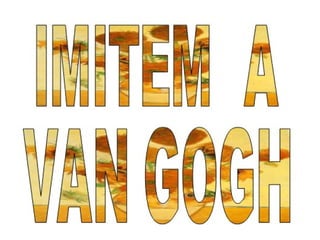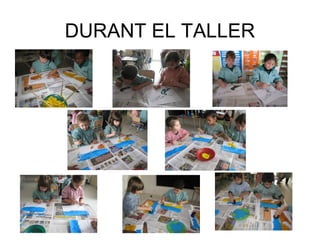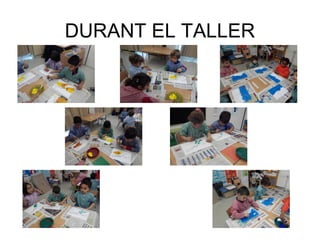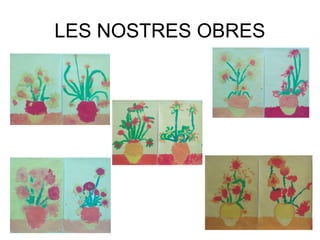Imitem a van gogh
Download as ppt, pdf0 likes521 views
This document discusses a workshop and some works. It mentions that during the workshop and some works were discussed, but provides no other details on the topic or content of the workshop and works.
1 of 7
Download to read offline







Ad
Recommended
Gestion de entrada y salidauacj
╠²
Este documento trata sobre los sistemas operativos y la gesti├│n de entrada y salida. Explica los tipos de dispositivos de entrada y salida, como los dispositivos legibles por humanos y m├Īquinas. Tambi├®n describe los controladores de dispositivos, las diferentes formas de entrada y salida, y los m├®todos para planificar el acceso a discos, como FIFO, SSTF y C-SCAN. Por ├║ltimo, menciona t├®cnicas para mejorar el rendimiento de los discos como el uso de cach├® y la redundancia de la informaci├│n.johannajohanna mejia mejia
╠²
El hardware de un computador incluye todos los componentes f├Łsicos necesarios para su funcionamiento, como circuitos, dispositivos de entrada y salida, y unidades de almacenamiento. En contraposici├│n, el software se refiere a los componentes l├│gicos que permiten realizar tareas espec├Łficas, como sistemas operativos y aplicaciones. Los dispositivos de entrada como teclados y ratones, y de salida como impresoras y monitores, son esenciales para la interacci├│n y presentaci├│n de informaci├│n en el sistema inform├Ītico.Fundamentos del software libre. (Maviola,Jos├®, Luis y Luisana)Maviola Pulido
╠²
El documento analiza el concepto y la importancia del software libre, especialmente en el contexto de Venezuela, donde su adopci├│n ha sido promovida por el gobierno desde 2004 para mejorar la administraci├│n p├║blica y la independencia tecnol├│gica. Se detallan las libertades esenciales del software libre, incluyendo su uso, modificaci├│n y redistribuci├│n, y se menciona el impacto positivo en comunidades y el desarrollo de proyectos como Canaima Educativo. Adem├Īs, el documento resalta la necesidad del trabajo colaborativo en el desarrollo de tecnolog├Ła libre, integrando diversos sectores de la sociedad.Fundamentos de softwarebelLoz
╠²
El documento define el software como el conjunto de componentes l├│gicos necesarios para realizar tareas espec├Łficas en un sistema inform├Ītico. Explica que existen diferentes categor├Łas de software como el software de sistema, de aplicaci├│n y los lenguajes de programaci├│n. Tambi├®n define el algoritmo como un conjunto de instrucciones ordenadas para resolver un problema y muestra ejemplos como el pseudoc├│digo y los diagramas de flujo. Por ├║ltimo, explica los pasos para escribir un programa y las funciones de un sistema operativo en una computadora.Gestion de softwareFrankely Hernandez
╠²
Este documento resume varios temas relacionados con aplicaciones de sistemas en la era digital, incluyendo logro de excelencia operativa a trav├®s de sistemas empresariales, software empresarial, cadena de suministro, relaciones con clientes, comercio electr├│nico, mercados digitales y bienes digitales. Explica conceptos como ERP, CRM, SFA y provee ejemplos de c├│mo estas aplicaciones mejoran la eficiencia y toma de decisiones en empresas.Fundamentos del softwareAnabel Santana
╠²
El documento describe diferentes tipos de software, incluyendo sistemas operativos, procesadores de texto, navegadores web, suites de oficina y otros programas comunes. Explica que el software se puede clasificar en aplicaciones de usuario, software integrado, paquetes de software y software de sistema. Tambi├®n cubre la relaci├│n entre hardware y software en una computadora.Gesti├│n de entrada salida eduardoed5
╠²
Este documento describe la gesti├│n de entrada y salida en los sistemas operativos. Explica los diferentes tipos de dispositivos de E/S, las t├®cnicas como el acceso directo a memoria y los algoritmos de planificaci├│n de discos. Tambi├®n cubre temas como los niveles de organizaci├│n de E/S, los esquemas de almacenamiento intermedio y las configuraciones RAID. El objetivo es proporcionar una soluci├│n general para la interfaz entre el sistema y los dispositivos perif├®ricos.Fundamentos Inform├Īticos Hardware SoftwareVideoconferencias UTPL
╠²
El documento habla sobre los fundamentos de hardware y software. Explica la estructura y organizaci├│n f├Łsica del computador, incluyendo componentes como la CPU, memoria, discos duros, teclado, pantalla y m├Īs. Tambi├®n describe los tipos de software como el sistema operativo y aplicaciones. Brevemente discute sobre bases de datos y los aspectos necesarios para contar con un software de calidad.Power final
Power finalllopez18
╠²
This document summarizes key facts about elephants. It describes elephants as large, herbivorous mammals that live in Africa and Asia. It notes that African elephants are the largest, with larger ears and longer tusks, while Asian elephants are smaller with smaller ears. It then lists and describes the elephant's main physical features, including its trunk, feet, tail, ears, tusks, and thick, gray skin.Van goghllopez18
╠²
Vincent van Gogh naci├│ en Holanda en 1853. Sus primeras obras mostraban la miseria y el sufrimiento humano de forma oscura. M├Īs tarde se mud├│ a Par├Łs donde se familiariz├│ con el impresionismo y comenz├│ a usar colores m├Īs brillantes. Luego se traslad├│ al sur de Francia donde comenz├│ a utilizar colores m├Īs intensos como el amarillo, el verde y el azul para pintar la naturaleza. Algunas de sus obras m├Īs famosas incluyen Los comedores de patatas, Naturaleza muertaImitem a kandinkyllopez18
╠²
Le document mentionne ├Ā plusieurs reprises 'nos ┼ōuvres'. Cependant, il ne fournit pas d'informations ou de contexte suppl├®mentaires sur ces ┼ōuvres.Kandinsky
Kandinskyllopez18
╠²
Wassily Kandinsky was born in Russia in 1866. He studied law and economics but also took drawing and painting classes. He was inspired by the works of famous painters Rembrandt and Monet. When he turned 30 years old, he decided to abandon his career path to study painting in Munich. There he befriended Paul Klee, forming a sincere and long-lasting friendship. His interest in color was already present early in his artistic career as shown through works like Squares with Concentric Circles, Various Circles, Color Studies, Composition VIII, Yellow, Red and Blue, Blue Sky, and Gravitation.Kandinsky
Kandinskyllopez18
╠²
Wassily Kandinsky was born in Russia in 1866. He studied law and economics but also took drawing and painting classes. He was inspired by the works of famous painters Rembrandt and Monet. At age 30, he decided to pursue a career in painting and moved to Munich to study art, abandoning his original career path. In Munich, he met Paul Klee and they became close friends. Early in his career, Kandinsky showed interest in color through works like Squares with Concentric Circles, Various Circles, Composition VIII, Yellow, Red and Blue, Blue Sky, Color Studies, and Gravitation that moved toward abstraction.Un dia amb els peixos
Un dia amb els peixosllopez18
╠²
The document appears to be notes from a classroom in another language. It includes a vote tally with various animals and vehicles, notes about arriving and putting on lab coats, sitting in a circle for attendance, discussing the date and activity, and a schedule mentioning Tuesdays for psychomotor activities and Thursdays for music. It concludes with a note about going home.Un dia amb els cavallers i les princeses p 4
Un dia amb els cavallers i les princeses p 4llopez18
╠²
The document describes the process of voting to name a classroom and counting the number of students interested in different themes like knights and princesses, elephants, cars, and motorcycles. It then discusses the daily classroom routine which includes hanging up coats, putting on lab coats, sitting in a circle to take attendance, discussing the weather and date, learning, working, playing, doing psychomotor activities, music, and going home at the end of the day.Som la classe de les marietes
Som la classe de les marietesllopez18
╠²
This document contains a list of 20 names, including Dalila, Ainara, Daniel, N├║ria, Sebastian, Nayma, Coraima, Nat├Ālia, Carla, Aylin, Ibai, Nil, Moussa, Erik, Rolan, Jan, Adri├Ā, Pau, Ana, and Adriana.Emocionsllopez18
╠²
El documento presenta un proyecto educativo sobre las emociones que incluye dibujos y actividades sobre la alegr├Ła, el aburrimiento, la tristeza y el miedo. Los estudiantes dibujan sus propios miedos y reflexionan sobre c├│mo se sienten, y al final leen una carta de despedida que cierra el proyecto.Un dia amb les marietes
Un dia amb les marietesllopez18
╠²
This document provides a summary of a typical school day for young children in three sentences:
The school day begins with hanging up coats, putting on smocks, and taking attendance. Students then learn, play at recess, eat snacks and lunch, and have different activities like music, art, and free play. At the end of the day, the children clean up, take off their smocks, and go home after learning and playing all day at school.More Related Content
More from llopez18 (14)
Power final
Power finalllopez18
╠²
This document summarizes key facts about elephants. It describes elephants as large, herbivorous mammals that live in Africa and Asia. It notes that African elephants are the largest, with larger ears and longer tusks, while Asian elephants are smaller with smaller ears. It then lists and describes the elephant's main physical features, including its trunk, feet, tail, ears, tusks, and thick, gray skin.Van goghllopez18
╠²
Vincent van Gogh naci├│ en Holanda en 1853. Sus primeras obras mostraban la miseria y el sufrimiento humano de forma oscura. M├Īs tarde se mud├│ a Par├Łs donde se familiariz├│ con el impresionismo y comenz├│ a usar colores m├Īs brillantes. Luego se traslad├│ al sur de Francia donde comenz├│ a utilizar colores m├Īs intensos como el amarillo, el verde y el azul para pintar la naturaleza. Algunas de sus obras m├Īs famosas incluyen Los comedores de patatas, Naturaleza muertaImitem a kandinkyllopez18
╠²
Le document mentionne ├Ā plusieurs reprises 'nos ┼ōuvres'. Cependant, il ne fournit pas d'informations ou de contexte suppl├®mentaires sur ces ┼ōuvres.Kandinsky
Kandinskyllopez18
╠²
Wassily Kandinsky was born in Russia in 1866. He studied law and economics but also took drawing and painting classes. He was inspired by the works of famous painters Rembrandt and Monet. When he turned 30 years old, he decided to abandon his career path to study painting in Munich. There he befriended Paul Klee, forming a sincere and long-lasting friendship. His interest in color was already present early in his artistic career as shown through works like Squares with Concentric Circles, Various Circles, Color Studies, Composition VIII, Yellow, Red and Blue, Blue Sky, and Gravitation.Kandinsky
Kandinskyllopez18
╠²
Wassily Kandinsky was born in Russia in 1866. He studied law and economics but also took drawing and painting classes. He was inspired by the works of famous painters Rembrandt and Monet. At age 30, he decided to pursue a career in painting and moved to Munich to study art, abandoning his original career path. In Munich, he met Paul Klee and they became close friends. Early in his career, Kandinsky showed interest in color through works like Squares with Concentric Circles, Various Circles, Composition VIII, Yellow, Red and Blue, Blue Sky, Color Studies, and Gravitation that moved toward abstraction.Un dia amb els peixos
Un dia amb els peixosllopez18
╠²
The document appears to be notes from a classroom in another language. It includes a vote tally with various animals and vehicles, notes about arriving and putting on lab coats, sitting in a circle for attendance, discussing the date and activity, and a schedule mentioning Tuesdays for psychomotor activities and Thursdays for music. It concludes with a note about going home.Un dia amb els cavallers i les princeses p 4
Un dia amb els cavallers i les princeses p 4llopez18
╠²
The document describes the process of voting to name a classroom and counting the number of students interested in different themes like knights and princesses, elephants, cars, and motorcycles. It then discusses the daily classroom routine which includes hanging up coats, putting on lab coats, sitting in a circle to take attendance, discussing the weather and date, learning, working, playing, doing psychomotor activities, music, and going home at the end of the day.Som la classe de les marietes
Som la classe de les marietesllopez18
╠²
This document contains a list of 20 names, including Dalila, Ainara, Daniel, N├║ria, Sebastian, Nayma, Coraima, Nat├Ālia, Carla, Aylin, Ibai, Nil, Moussa, Erik, Rolan, Jan, Adri├Ā, Pau, Ana, and Adriana.Emocionsllopez18
╠²
El documento presenta un proyecto educativo sobre las emociones que incluye dibujos y actividades sobre la alegr├Ła, el aburrimiento, la tristeza y el miedo. Los estudiantes dibujan sus propios miedos y reflexionan sobre c├│mo se sienten, y al final leen una carta de despedida que cierra el proyecto.Un dia amb les marietes
Un dia amb les marietesllopez18
╠²
This document provides a summary of a typical school day for young children in three sentences:
The school day begins with hanging up coats, putting on smocks, and taking attendance. Students then learn, play at recess, eat snacks and lunch, and have different activities like music, art, and free play. At the end of the day, the children clean up, take off their smocks, and go home after learning and playing all day at school.